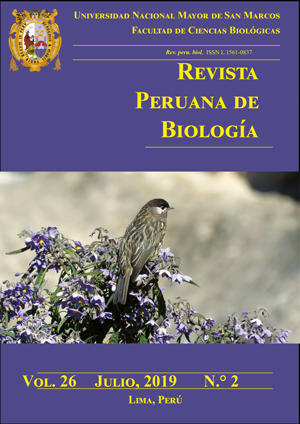Genetic diversity in three populations of Physalis peruviana using fractionation and electrophoretic patterns of seed storage protein
DOI:
https://doi.org/10.15381/rpb.v26i2.16370Keywords:
SDS-PAGE, Peru, ecotypes, genetic difference, Solanaceae, golden berryAbstract
The genetic diversity of three populations designated as ecotypes of golden berry (Physalis peruaviana) is studied using protein quantification and polymorphism of seed storage proteins (SSPs) by denaturating polyacrylamide gel electrophoresis (SDS-PAGE). As well, biochemical characteristics of seed proteins were identified. The populations were from San Pablo province (Agroandino ecotype), Celendín province (Celendino ecotype) and Cajabamba province (Cajabamba ecotype), all from Cajamarca Department. There was not difference among the three populations based on protein quantification. Globulins (82.4%) were the majority fraction followed for albumins (13.9%), glutelins (3.7%) and prolamins (0.7%). Only albumins showed polymorphism, showing 21 proteins between ~6.5 to ~45 kDa and three different electrophoretic profiles, which were share among the three populations. Legumins and vicilins were identified in globulin fraction. Glutelins showed proteins of same molecular weight (MW) to legumins; and prolamins only a band of low MW. San Pablo province population (Agroandino ecotype) was completely uniform, while Cajabamba population showed higher genetic diversity followed by Celendin population. Our results shows that, based on seed proteins analyses is not possible to distinguish the three populations designated as Agroandino, Cajabamba and Celendino ecotypes.
Downloads
Downloads
Published
Issue
Section
License
Copyright (c) 2019 Henry Bonilla, Yajahaira Carbajal, María Siles, Alberto López

This work is licensed under a Creative Commons Attribution-NonCommercial-ShareAlike 4.0 International License.
AUTHORS RETAIN THEIR RIGHTS:
a. Authors retain their trade mark rights and patent, and also on any process or procedure described in the article.
b. Authors retain their right to share, copy, distribute, perform and publicly communicate their article (eg, to place their article in an institutional repository or publish it in a book), with an acknowledgment of its initial publication in the Revista Peruana de Biologia.
c. Authors retain theirs right to make a subsequent publication of their work, to use the article or any part thereof (eg a compilation of his papers, lecture notes, thesis, or a book), always indicating its initial publication in the Revista Peruana de Biologia (the originator of the work, journal, volume, number and date).






